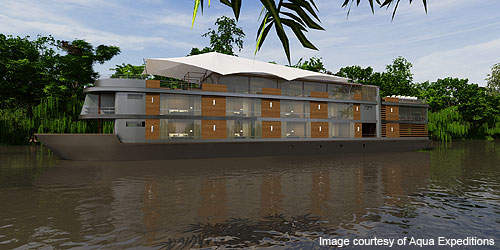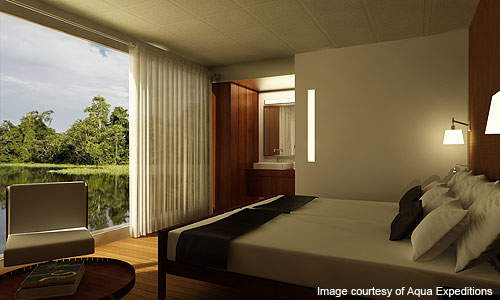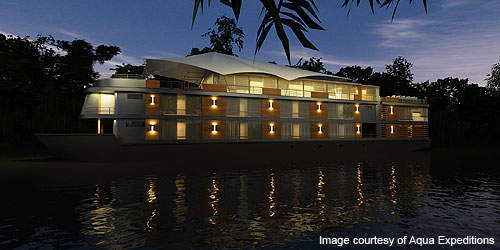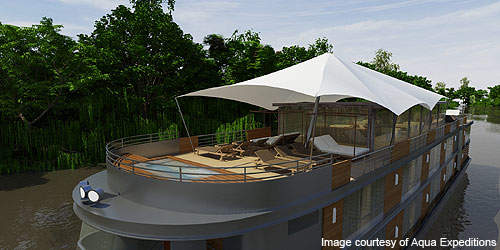M/V Aria was the second luxury cruise ship to join the fleet of Aqua Expeditions on the northern part of the Amazon River. It was built at the company’s shipyard in Iquitos, Peru, and was launched in April 2011. Aqua Expeditions, the owner and operator, spent $4m on the ship.
An embarkation lounge was opened on the edge of Nauta, a tributary of the Amazon, in November 2010. It offers comforts to embarking and disembarking passengers of the M/V Aria and Aqua.
The lounge was designed by Jordi Puig and features a refreshment area, relaxing cushioned chairs and bathroom facilities.
M/V Aria design features
M/V Aria has been designed for a higher capacity than its sister ship, M/V Aqua. It was custom built by Peruvian architect Jordi Puig. The length, width and draft of the Aria are 45m, 9m and 1.5m respectively. The gross tonnage is 500t.
The cruise ship features a water treatment plant with a capacity of 9,000l.
Facilities onboard the luxury cruise ship
The cruise ship is comparable to a 5-star hotel, with private baths and luxury standard toiletries and bedding. The top deck accommodates an observation lounge, an outdoor whirlpool bathtub and a sun deck.
The ship also features an indoor bar lounge, reference library, dining room, exercise room and a boutique.
Passengers can spend their leisure time on the observation deck. The indoor bar lounge is fully air conditioned. The outdoor lounge features a cold water whirlpool bathtub meant for guest refreshment after excursions.
The exercise room is equipped with treadmills and elliptical machines. It features full glass walls to provide panoramic views. The boutique offers a collection of arts and crafts from the Amazon region and Peru.
The cruise ship has four aluminium launch boats onboard which double as life boats in case of emergency. The boats are powered by four-stroke, low emission engines. Each boat has the capacity to accommodate eight to ten passengers and be provided with a guide and launch pilot.
A crew member is assigned on the navigation deck to monitor whether the vessel is sailing or docked. A paramedic is available onboard to provide medical attention to passengers where necessary. The cruise ship is equipped with satellite phones, backup radio communication equipment, emergency lighting and signs in the passage ways.
The ship generally serves Peruvian cuisine but special diets are accommodated for, provided one month’s notice is given.
Accommodation on Aqua Expeditions’ cruise vessel
M/V Aria has a capacity to accommodate up to 32 passengers. In addition, a child can be accommodated in each cabin.
There are 16 suites, eight on the first deck and eight on the second. The suites measure 240ft² each. Four of the 16 cabins are interconnecting suites for families.
Each cabin features twin beds which can be converted into a king-sized bed. The cabins also feature a sitting area, an internal communication system and bathrooms equipped with a shower, sink, cabinet and hairdryer.
All the suites face outside and have large panoramic windows. As a security measure, life jackets, fire extinguishers and smoke detectors are provided in the cabins. All the cabins feature safe deposit boxes for valuables.
The cruise ship is fully air conditioned throughout. The suites and lounge feature floor-to-ceiling windows too.
Crew, propulsion and itinerary
The cruise ship has a crew of 24 people. It also has four English speaking guides.
The cruise ship is powered by two Cummins diesel marine engines of 4,000hp and two Cummins generators of 135KVA. The propulsion system provides a cruising speed of 12kts.
The maiden voyage of Aria began in April 2011. It started at Iquitos to travel through Yanayacu, Yanallpa Creek, the Maranon River, the Samiria River, Pacaya Samiria National Park, Yanayacu Pucate and Charo Lake.





